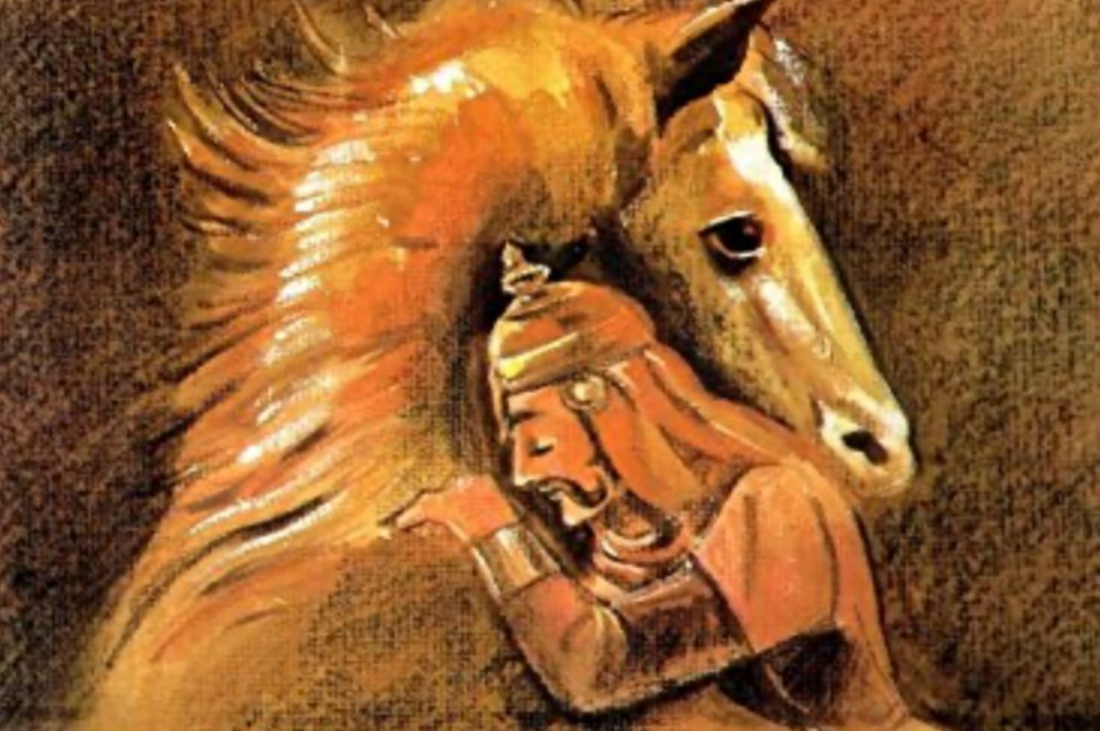
India’s Unforgettable Horses
Share
“Bundele Har Bolon Ke Muh Humne Suni Kahaani Thi, Khoob Ladi Mardani Woh Toh Jhansi Waali Rani Thi.”
We grew up singing these echoes of resistance.
But in every story of Rani Lakshmibai — the fearless queen who fought the British with unmatched valor — there was another hero, often unnamed: Badal, the horse who carried her through fire, sword, and surrender. When Jhansi fell, Badal rose — leaping from high ramparts with the queen on his back, injured and exhausted, but loyal till his last breath. He did not survive the fall, but Rani did — long enough to write her final chapter.
Badal, like so many of India’s horses, was more than just a steed. He was a warrior, a witness, and a partner in war. India’s history is filled with hoofprints like his — some recorded, most forgotten.
Chetak — The Blue-Warrior’s Blue-Blooded Steed
Perhaps the most storied horse in Indian memory is Chetak, the valiant stallion of Maharana Pratap. Blue-bodied and lion-hearted, Chetak carried the Rajput king in the Battle of Haldighati against the Mughal empire. Even after being fatally wounded, Chetak galloped across a river to save his rider’s life — before collapsing. A cenotaph still stands in his honor in Rajsamand, Rajasthan. Few animals in the world are remembered as monuments. Chetak earned his.
Uchchaihshravas — The Celestial Horse
In mythology, the horse Uchchaihshravas emerged from the cosmic churning of the ocean, Samudra Manthan. Considered the king of horses, he was snow-white, seven-headed, and divine — the symbol of supremacy, born from the union of gods and creation. He belonged to Indra, the king of the devas, and later was coveted even by asuras (demons), such was his might and magnificence.
Devadatta — Arjuna’s Chariot Horse
In the Mahabharata, when Arjuna went to battle, he rode on a chariot gifted by Agni and driven by Lord Krishna. The horse yoked to this divine chariot was Devadatta, a steed said to be born of wind and fire, capable of crushing darkness with every gallop. In Kurukshetra, Devadatta was not just part of Arjuna’s armor — he was an extension of his will.
Shivaji Maharaj’s Loyal Companions
The founder of the Maratha Empire, Chhatrapati Shivaji Maharaj, had several trusted horses, the most revered being Moti and Vishwas. These horses were trained for guerrilla warfare in the Sahyadri hills and could travel silently, swiftly, and across treacherous terrain. It is said that Moti once crossed flooded rivers at night to carry Shivaji Maharaj to safety, after a daring escape from enemy clutches.
His son, Sambhaji Maharaj, was equally dependent on his horses. In fact, the Maratha cavalry became one of the most formidable horse-riding forces in Indian history, outmaneuvering better-equipped enemies through sheer agility and courage — not just of men, but of their mounts.
The Forgotten Horses of Everyday Valor
Not every horse had royal lineage. Countless unnamed horses carried messengers, poets, soldiers, and pilgrims across centuries. In desert caravans, they bore silk and salt. In wars, they bore generals and fallen friends. In processions, they stood tall with painted foreheads and silver saddles. India’s equine heritage runs from the Marwari and Kathiawari breeds of Rajasthan to the Manipuri ponies of the Northeast — each with their own legacy of strength, loyalty, and cultural pride.
Do We Still Remember Them?
Today, most history books speak only of rulers and empires. The animals that galloped alongside — shaping, saving, surviving — are often left in the margins. But without them, there would be no battlefield heroics, no midnight escapes, no legends of warcraft or wonder.
India’s horses are not just creatures of the past. They are carriers of memory. The bond between human and horse has always been unspoken — built on trust, rhythm, and instinct. And yet, it shaped the fate of kingdoms.
As we reclaim our heritage, revive our arts, and re-tell our stories, let us remember their hoofbeats, too.
Because when empires rose and fell, they were there.
Not just ridden — but remembered.
Not just fast — but faithful.
And not just beasts — but brothers in arms.

